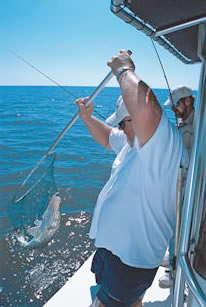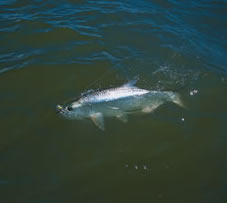November 05, 2012
By Steve Kantner
Where modern and mangrove meet.

This redfish may be a bit oversized, but certainly put up a scrappy fight. |
Goodland is one of the last frontier outposts in Florida. Situated between cosmopolitan Naples and the rustic isolation of Chokoloskee Island, the settlement's defining virtue is that it serves as both a northern gateway to the Ten Thousand Islands and a direct route to the offshore reefs and wrecks that pepper this portion of the Gulf of Mexico.
Miles of mangrove shoreline provide a backdrop more appropriate for Calusa warriors than electrical subcontractors, although both have left their mark here. Despite a weathered dock or two, Nature appears to be pervasive. I might add that Her influence extends to the bottom grasses and oyster bars that define the local shallows—not to mention the trees, islands and shoals rearranged last fall by Hurricane Wilma.
There's human influence, too.
The first time I saw Goodland, its number one attraction was a waterfront saloon that hosted a Mullet Festival. I'm happy to report that Stan's is still standing, even after the Category 3 storm, and that organizers looked foward to a big Festival Jan. 20-22 this year.
At one time, this was strictly commercial fishing country. Species like mullet, snook and seatrout provided the region's inhabitants with a living for decades. Then things changed dramatically. Someone might go so far as to wonder what's in store for Goodland, now that gill nets are a thing of the past.
I believe there's an answer and it lies in the region's light-tackle guides who've made the transition from mesh to mechanization with the help of rods and reels.
Goodland is the geographical epicenter of thousands of square miles of waist-deep shallows that stretch endlessly toward Florida Bay. Navigational charts identify hundreds of shallow bays and nearshore grassflats.
Captain Keith Thompson is a third-generation local who knows the fishing here like the back of his sunburned hands. Mike Keetch and I met Keith at Calusa Island Marina, although he normally docks closer to Marco, which reminds me that if you don't have a map in front of you, Goodland is actually located on Marco Island.
While we were motoring from the marina, I asked Keith to describe his typical customer.
“I cater to a lot of trout fishermen, but my customers also like to fish for snook and redfish,” he said. “During wintertime when the trout season shuts off, we'll drift the grassbeds and jig for pompano.”
Other migratory species also enter the local fishery. According to Keith, “We get a lot of Spanish mackerel and bluefish over the inshore reefs and grassbeds. It's mostly a winter fishery, but lately, the mackerel have been hanging around all year.”

Angler Mike Keetch and fishing guide Keith Thompson introduce a backwater snook to a modern by boat. |
It's ironic that the first catchable fish I saw that day was a leaping Spanish mackerel. When I say catchable, I'm making the distinction between fish that strike lures and the countless legions of mullet that choke the local shallows. Something else that immediately caught my eye was the juxtaposition of wilderness and opulence. The air was redolent of swamp gas, but new construction was visible everywhere. When I questioned Mike about it, his lament had a familiar ring: “They're building more condos.”
I also saw million-dollar homes, which in all fairness to the architects, at least paid lip-service to Frank Lloyd Wright's concept of form following function. We passed another marina. It appeared to be reasonably busy.
Keith put the boat on plane and we began running south in silence. When he finally throttled back, it was deep in the Ten Thousand Islands. If you asked me where, I'd say that I didn't know for sure—except that Keith and Mike kept talking about pumpkins. We subsequently made a series of other stops, each time lingering just long enough to check out a particular shoreline. Keith had us casting jigs tipped with a piece of fresh shrimp and after a slow start, he was the first to hook a fish, a small mangrove snapper.
A moment later, Mike hooked a second mangrove and soon Keith was fast to another.
“C'mon, Sean,” a voice chided, “you're missing out on the action.”
Unfortunately, I had hooked a mangrove of my own. Despite Keith's offer to help, I hesitated to interrupt their fishing, choosing instead to wait until after the snapper spate subsided to motor to where I could recover my jig from the rubbery mess.

Keeper-size snook prowl these waters. |
We moved again, this time to a spot where my patience was finally rewarded. The mangrove gods immediately granted me two undersize redfish. A bald eagle circling overhead threatened to rain on our parade. Nevertheless, I decided to forget about guano and pay close attention to my jig, which was the right decision since we subsequently landed several other reds, plus two or three small snook. The action eventually slowed, and since the tide was falling rapidly, Keith decided to slip our surly mangrove bonds and touch the face of grass.
A moment later, we were racing toward the open Gulf. We passed only one other guide while in transit. From the looks of things, his party was soaking shrimp on popping corks.
Our backcountry trek had been memorable. The most amazing part was that during the entire several-hour period, we encountered fewer than a handful of other anglers. The most formidable of these was wearing feathers, which narrowed it down even further.
Once we cleared the pass, Keith headed south to an area surrounded by channel markers. The water was slightly off-color. After coasting to a stop, we started drifting across an invisible flat that Keith claimed harbored large seatrout. The prospect intrigued me, so I questioned him further.
“We don't catch really big trout,” he replied, “but get plenty in the 3- to 5-pound range. When the weather gets cold during the winter, the fish move inside to the potholes.”
So far, the only trout I'd seen was a throwback we'd lost in the backcountry. Still, we'd caught a number of small snook and reds, which combined with the overriding ambience to provide a stellar experience. I'll admit that I was thinking about dinner. However, the flat failed to deliver and with the exception of a few ladyfish and catfish, we remained fishless.
About the time I reached for a second helping of sunscreen, Keith decided to fire up the outboard and run. I'd been hearing about an inshore “reef” he'd discovered. I never figured out exactly what lay on the bottom, but Mike assured me that three weeks earlier the sunken obstruction had offered up a piscatorial smorgasbord that included several large tarpon and a jewfish.

Opulence in the wilderness. |
The move gave me an opportunity to view my surroundings. While the boat cruised effortlessly, I reveled in an unparalleled view of Cape Romano. Meanwhile, I was able to distinguish certain features among the mangroves, one of which appeared to be Goodland although I couldn't say for sure. Keith and Mike were huddling around the GPS unit and occasionally checking the depth recorder for signs of sunken debris, so when Keith pulled back on the throttle, I knew we'd hit our mark.
As soon as the boat came to rest, Mike reached for the anchor while Keith retrieved his trusty shrimp net. Judging from the recorder screen, we were situated in approximately 10 feet of water over a loose aggregation of fish. We began casting our jigs and shrimp but as it turned out, to no avail.
It was several minutes later that I noticed the almost complete absence of tide. Having fished Gulf wrecks before, I understood the importance of current. Nevertheless, it was a pleasant day and I soon found myself immersed in that groundswell of drowsiness that's drowned many a sleepy angler in its flood.
My nap was short-lived. I awakened abruptly to discover Keith fighting something substantial from the bow.
The battle reached a successful conclusion when Mike slapped the twine to a keeper snook.
I subsequently landed a real trophy, but only among the catfish ranks. There were several more cats in quick succession, but none reached the dimensions of this singular chap. Before I could unhook the last of these finny nuisances, Keith came tight again.

A fast strike revealed this feisty tarpon. |
Strikes came regularly now. Mike's tip snapped downward in an arc. Line slipped grudgingly from his reel and seconds later, a 4-foot tarpon exploded within spitting distance of the boat.
After nearly 15 minutes and several trips around the boat, Mike succeeded in bringing the 35-pounder alongside where Keith was able to release it.
It had been quite a day. But when the trip was finally over, I felt refreshed rather than tired the way you'd suspect. After all, it had been quite awhile since I'd enjoyed such a salubrious combination of solitude and good fishing. What's more, the fact that I didn't have to have my teeth rattled made it that much better.
As far as moving to Goodland, I'm not recommending it. On the contrary, I'd rather you visit and leave the homesteading to the locals and the birds. What I did learn from this assignment is that some things transcend glitz. One, to my way of thinking, has to do with quality recreational time.
Spotlight on Goodland
Goodland and Marco Island were up and running quickly after Hurricane Wilma in late October 2005. Residents reported some fallen trees and other wind damage to homes and boats. One building at Coon Key Marina was flattened, and there was some minor structural damage to Stan's restaurant.
In the words of Mike Keetch, “You'd hardly know it happened. The ramp's open. The bait shack at the marina suffered some minor damage, but we were otherwise unaffected.”
To get to Calusa Island Marina, take U.S. Highway 41 to State Road 92, then follow the signs to Goodland. Take the first left after crossing the causeway and then the first right before following the road to the marina. You'll find a launch ramp and floating dock, as well as a ship's store. The marina charges a launch fee.
Because of downed trees and shifting bars, boaters should operate with more than the usual amount of caution when navigating the mangrove country.
FS
Florida Sportsman Classics February 2006

